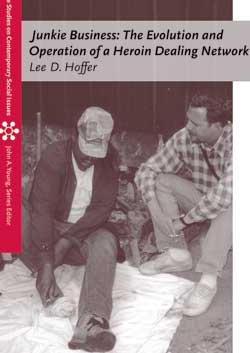(Thomson-Wadsworth Publishing; December 2005)
While pursuing a doctorate, Lee Hoffer worked with a small research group at the University of Colorado Health Sciences Center.
The group, called “Urban Links” conducted HIV prevention projects and specialized in ethnographic research, which required interviewing and observing active drug users’ behaviors within the natural context in which they occurred.
This meant establishing rapport with drug users and going into the field with them.

It was there Hoffer met two homeless heroin users, Kurt and Danny, and the nexus for Hoffer’s book Junkie Business: The Evolution and Operation of a Heroin Dealing Network was born.
The work is an ethnographic case study of how these two users became heroin dealers and operated their dealing network from 1997-2000 in Denver.
“I have always been interested in the distribution of illegal drugs,” Hoffer said. “All drug users engage the illicit drug economy through sales or exchange, and many drug users participate in selling drugs to support or defray the costs of their addictions.
“However, studying these topics is not something one can easily plan to do, especially from the research perspective of the dealer.”
But having met Kurt and Danny through Urban Links, trust and rapport had already been established, so the two allowed Hoffer near-unfettered access into their lives.
“I became a fixture at Kurt and Danny’s apartment,” Hoffer said. “For months I watched them sell heroin and interviewed them about what they were doing. I also interviewed many of their customers.”
The central aim of Junkie Business is to describe how an illegal business — selling heroin – developed and was operated. The research covers the period prior to the main dealers selling heroin and documents how the operation progressed from a loose-knit street-based partnership to a private business with a clear and well-organized division of labor.
How the business changed the lives of the dealers also is a consistent theme.
The magnitude and resiliency of the underground economy associated with the distribution of heroin is astounding. Maintenance of a heroin addiction requires daily use of the drug.
Because addicts typically cannot maintain a surplus they often have to purchase the drug every day.
With estimates of between 1 million and 3 million heroin users in the United States, the daily numbers of heroin sales are striking. But in spite of this considerable activity, little is know about how clandestine organizations that sell heroin operate, adapt or change over time. The day-to-day life of a heroin dealer remains a mystery.
At least until Hoffer came along and met Kurt and Danny.
Hoffer admits he went into the study with some preconceived assumptions about drug-dealers and violence, but those notions were quickly dashed after witnessing firsthand the day-to-day operations.
“When I began this study, I thought about heroin dealing (and all drug dealing) like most people think about illegal drug dealing, namely that it is violent, chaotic, unorganized and unpredictable,” Hoffer said.
“My research project came to focus on why were Kurt and Danny successful heroin dealers? Ultimately, selling heroin was very hard work and it did not free the dealers from responsibility. As their only source of income, eventually the business took on a life of its own, and for Kurt and Danny there was simply no way out other that to continue to deal.
“Ultimately, the book details how the organization the dealers created and managed was not chaotic,” Hoffer added. “On the contrary, in all illegal drug markets there are rules and structures that organize both customers’ and dealers’ behaviors. The system works because most of the time users follow those rules.”
— Andy Clendennen